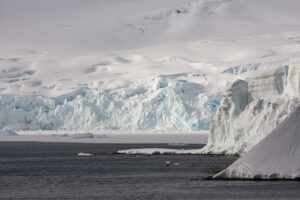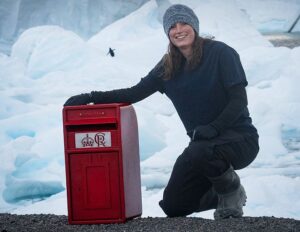Antarctica remains in a near-record deep freeze. But scientists call it a blip in a warming world.
Between April and September, the average temperature at the Amundsen-Scott South Pole Station was −61°C. That’s the coldest winter since records began in 1957. Climatology journalist Stefano Di Battista first tweeted about the extreme temperatures, and a NASA researcher later confirmed it. Experts point to a polar vortex and an ensuing ozone depletion as the culprit behind the deep cold.

Summer is comparatively balmy at the Scott-Amundsen Station, South Pole. Photo: Mesa Studios/Shutterstock
The cold temperatures extended elsewhere in Antarctica, leading to a near-record extent of sea ice, according to the Washington Post. Even now, with spring well underway, the Antarctic continues to experience record and close-to-record lows. A few days ago, Russia’s Vostok Station reached -79.4˚C, just a fraction of a degree above the coldest October temperature ever.

Image: National Centers for Environmental Information
A blip in the data does not a trend make, and experts everywhere agree that climate change is still a serious problem both worldwide and in the Antarctic, where rapid ice melt continues to contribute to sea-level rise. Ironically, while Antarctica froze, the planet as a whole experienced its fourth-hottest temperatures ever from June through August.
The Antarctic expedition season is right around the corner, but as the sun rises higher, comparative warmth may strike the currently bone-chilling Plateau. Stay tuned for our expedition roundup — dropping later this week — to find out who might be contending with this year’s epic conditions.
Extra credit: the 300 Club
Researchers holed up at the Amundsen-Scott Station know how to manufacture a good time. Enter the exclusive, elusive, and infamous 300 Club, est. 1959. The name borrows from an esteemed ritual in which inductees must experience a temperature change of 300° Fahrenheit (148°C) — but more on that in a moment.
Taking the 300 Club’s pledge requires some real steel, both in character and…well, other areas. Starting at the Station’s 93°C sauna — and wearing nothing more than a pair of bunny boots, aspiring 300 Club members must streak 100 yards across an icy field and through at least -55°C temps to touch the red-and-white ceremonial South Pole globe. Torch-wielding bystanders cheer the candidates on, adding to the refinement of the tradition.
But, reports Svati Kirsten Narula for The Atlantic, the undertaking is not for the ill-prepared:
“Make no mistake: Streaking at the South Pole isn’t an activity to be taken lightly. And it’s not something you do on a whim, after one too many shots of whiskey at Club 90 South. On the contrary, getting naked in Antarctica is a hallowed tradition that requires planning and teamwork.
“…The cold air and the low pressure combine to produce a ‘physiological altitude’ that exceeds the 10,000-foot physical altitude and changes every day according to the barometric pressure.
“…One of the first things people wonder about when they learn of the 300 Club is the incidence of frostbite. Perry and others who have been there confirm that this is a valid concern.”
Once you’re in the 300 Club, you’re in for life. No word on whether any new members joined the club last winter.

Photo: Vladimir Salman/Shutterstock






